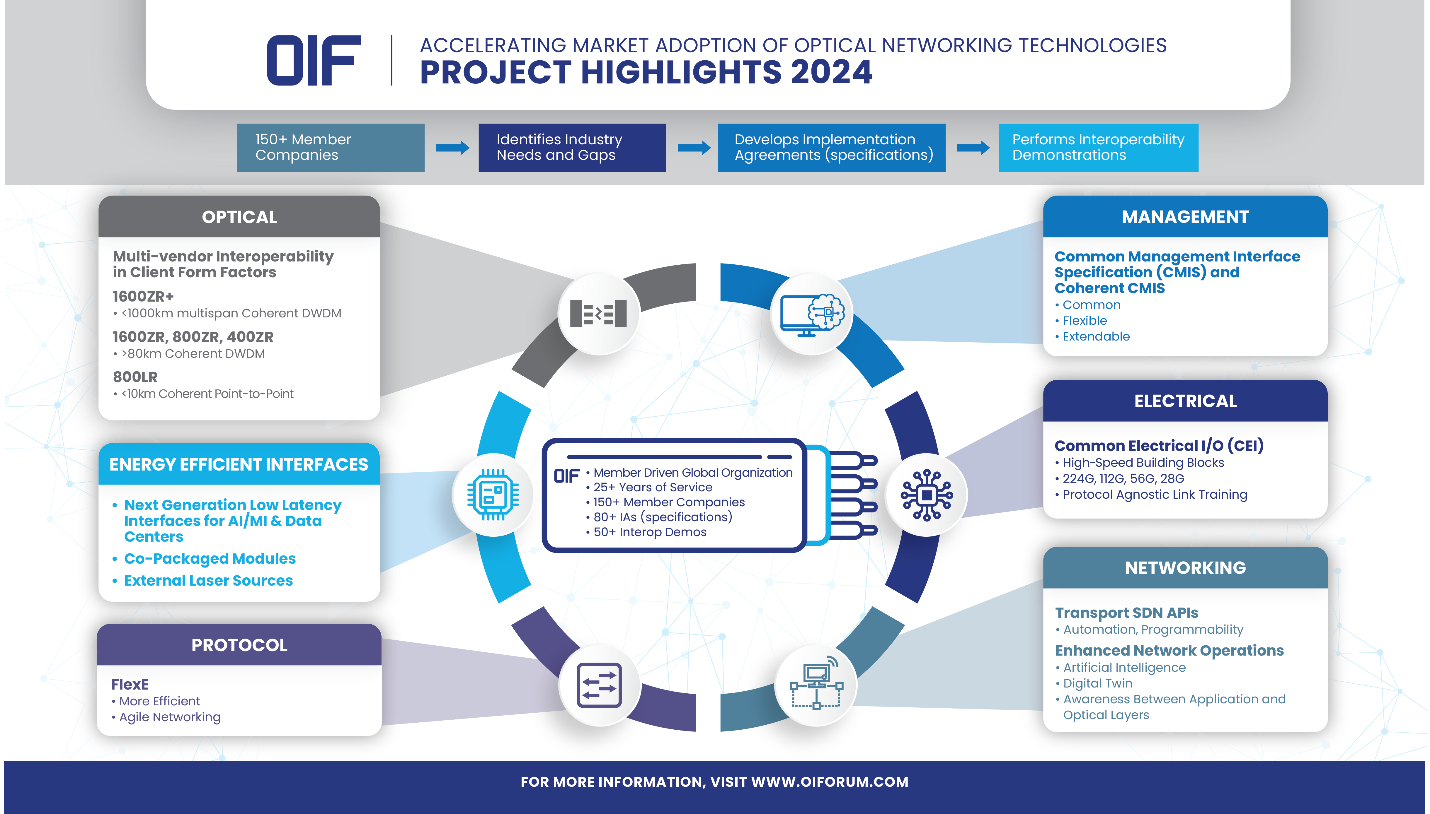By Mike Klempa, OIF Physical & Link Layer Interoperability Working Group Chair and Alphawave Semi
OIF has always been at the forefront of collaboration and advancement in the optical networking industry, recognized as the hub where interoperability solutions thrive. That work has now evolved into massively supported demonstrations, pushing the limits of OIF’s implementation agreements (IAs) in terms of capabilities, reach and performance. And, OIF continued to one-up itself in Common Electrical I/O (CEI) channels CEI-112G VSR, MR and LR application spaces as new products, SerDes, connector types, get optimized. This is also true for the 400ZR, Common Management Interface Specification (CMIS) and Co-Packaging projects that have been pillars of our demonstrations around the world since things picked back up at OFC 2022.
As part of its ongoing commitment to the industry, OIF publishes white papers that summarize the findings from its pretesting events for its interoperability demonstrations. One shining example is the 400ZR+ Interoperability White Paper, which produced a 400ZR+ Interop rOSNR Test Results interoperability matrix, comparing different vendor’s receiver performance across other vendor transmitter modules. This encouraged implementors to figure out how to play nicely with others, and reduce the rOSNR interoperability discrepancies, through iterations of this exercise at plugfests for OFC 2023 and ECOC 2023. OIF is excited to share that 800ZR interoperability of pre-IA solution implementations will be demonstrated at OFC 2024, the next step in the pluggable coherent roadmap for interoperability.
Over numerous years of multi-vendor interoperability demonstrations, OIF has crafted a formula that combines ongoing technological advancements with an engaged membership eager to participate, to propel the ecosystem towards progress. This continues to drive record turnout for the OIF’s demonstrations.

Always iterating and building on our interoperability demonstrations, like the recent addition of the CEI Linear project to our list of IAs, OIF addressed non-retimed interfaces in a similar manner. What started as a humble setup of an evaluation platform driven by test and measurement equipment has evolved into a complete ecosystem demonstration, showcasing multi-vendor Linear Pluggable Optics (LPO) interoperability, across all relevant flavors of optics, with test and measurement points probing each stage of the representative link. Interoperability between retimed DSPs and unretimed LPOs round out the LPO test matrix. As more vendors and products are released that support CEI-112G-Linear, we expect this demonstration to grow.
As the world continues to hear about the I/O bandwidth bottleneck in applications such as AI, OIF is spearheading this new generation towards multi-vendor interoperability. At ECOC 2023 OIF showed the industry’s first multi-vendor interoperability at 224G, ushering in the next era of critical work OIF is doing on CEI and interoperability. While OIF is just getting started at 224G, this is proof that the excitement for support and industry demand for solutions already.
Supporting an ecosystem of 224G will not be straight forward, because losses begin to stack up exponentially when compared with previous generations of CEI. The OIF CMIS Link Training (LT) project was started to catch up with the industry, implementing a link training from the host to the module, and a project start meant to be co-designed with 224G electrical agreements has also been started. Link Training at 224G will squeeze every ounce of margin for more future interoperability links because even VSR loss budgets at 224G are on the complexity of 112G LR channels.
In the short term, there is a lot of work to be done. But ultimately this will simplify the path towards plug and play multivendor interoperability and CMIS is a common, flexible and extendable management interface that enables hosts to seamlessly integrate and provision third-party modules.
OIF is also addressing the next generation interfaces for AI/ML & data centers, with a focus on driving down the energy to transfer bits around while also increasing bandwidth density of these interfaces. This topic really lumps all of the aforementioned critical points into one potential problem to solve, from interoperability, 224G and complex electrical losses, and optics all being scrutinized and co-designed together into the Energy Efficient Interfaces (EEI) project. OIF is looking into the crystal ball and preparing for a future where heterogenous chips will need to integrate connectivity into the package to obviate the electrical losses, which are becoming serious roadblocks. As an agnostic forum, we investigate solutions from different groups to leverage the work we have done in die to die, optical, copper cable, backplane and unretimed interfaces. This homogeneity of interfaces can mitigate ASIC complexity through interoperability, with readily available off the shelf I/O, memory, or compute chiplets.
And if any of this piqued your interest, please check out our demo at OFC, booth #1323!
Posted: 22 February 2024 by
Mike Klempa, OIF Physical & Link Layer Interoperability Working Group Chair and Alphawave Semi
| with 0 comments